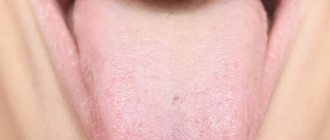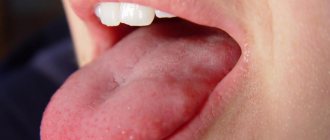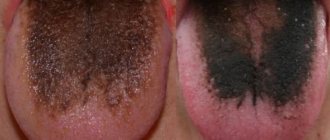Quick transition Treatment of a short frenulum of the tongue
A short frenulum of the tongue (ankyloglossia) is one of the most common minor anomalies in the development of the oral cavity.
The frenulum of the tongue is a fold of the oral mucosa that runs along the midline and connects the floor of the mouth with the lower surface of the tongue.
The function of the tongue frenulum is to fix the tongue to the soft tissues of the oral cavity, preventing tongue retraction (glossoptosis), especially during the neonatal period.
Symptoms
When crying, the tip of the baby's tongue bifurcates in the shape of a stylized heart.
The baby cannot stick his tongue out of his mouth. To test this reflex, you can run your finger over the baby's lips. Normally, the baby sticks his tongue out quite far, moving it around his lips in search of mother's milk.
Breastfeeding takes a lot of time, the baby is capricious, nervous, and clicking sounds are heard when sucking.
The baby is not gaining weight well.
A child with a short frenulum cannot reach the palate with his tongue.
There is a noticeable disturbance in the pronunciation of certain sounds during speech formation.
With a short frenulum (less than 1.5 cm), if it is attached to the soft tissues of the floor of the mouth, functional disorders do not always occur. These include difficulty sucking during breastfeeding and disturbances in sound pronunciation during the formation of phrasal speech.
Main symptoms
Sometimes the presence of cracks and grooves in the tongue is not accompanied by unnatural or painful sensations and can only be detected during examination by a dentist, ENT specialist or therapist. But this doesn't always happen. Patients often complain of the following related problems:
- pain;
- burning sensation;
- feeling that the tongue is loose;
- there is blood and ichor;
- elevated temperature;
- swelling and itching appeared;
- it becomes painful to chew;
- there is a problem with speech;
- increased salivation appeared;
- change in natural color;
- taste disturbance;
- the appearance of an unpleasant odor.
If cracks appear on the tongue, and the phenomenon is accompanied by one of the listed symptoms, then they speak of a progressive disease. This inflammatory process is referred to as glossitis; the prognosis for recovery from it is usually favorable. The appearance of erosions, furrows and ulcers indicates damage to the deep parts of the tongue. In this case, you should definitely contact a specialist.
Sometimes the tongue cracks and becomes covered with ulcers due to general damage to the ENT organs. Thus, tonsillitis or fungal pharyngitis can cause swelling and the appearance of white grooves. This condition is not isolated as an independent disease. Treatment in such cases begins with eliminating the underlying problem.
Consequences of frenulum anomaly
Hypotrophy due to impaired sucking, poor weight gain in infants.
Malocclusion, the first signs of which during the period of temporary occlusion is the rotation of the central lower incisors to the lingual side.
Impaired development of the lower jaw, as a result, the formation of a distal bite.
Local gingivitis, periodontitis up to exposure of the roots of the teeth in the area of the lower jaw incisors.
Violation of the pronunciation of sounds that require raising the tongue upward: “sh”, “zh”, “sch”.
Impaired language development due to asymmetrical growth. Low mobility of the tongue impairs the articulation of some sounds. Violation of diction (clarity, intelligibility of pronunciation).
Why does my tongue hurt?
Physiological reasons
Pain in the tongue is often the result of minor injuries: superficial burns from too hot liquid, accidental biting, damage from hard pieces of food, fish bones.
Painful sensations are combined with numbness or, on the contrary, hypersensitivity. They disappear within a few minutes or hours, less often – days. Burning and sore tongue can also be caused by eating spicy foods, certain spices, or drinking strong alcoholic beverages. In people who smoke, the sensitivity of the tongue increases due to the constant effect of tobacco smoke on the mucous membrane, which leads to the frequent occurrence of pain under the influence of other irritants.
Traumatic injuries
More serious injuries occur due to biting the tongue during an attack of epilepsy, sports, or accidents. Abrasions and wounds in the form of teeth marks are found on the tongue. Depending on the severity of the damage, pain lasts from several days to 1-2 weeks. In patients with incorrectly selected orthodontic structures or poorly fitted removable dentures, pain becomes the result of chronic irritation of the tongue. With advanced caries, the organ is systematically injured by the sharp edges of the teeth.
Glossitis
Pain syndrome is not observed with all glossitis; it is more typical for infectious lesions. The inflammatory process of bacterial etiology is manifested by hyperemia, swelling, increased local temperature, aching, raw pain. With viral glossitis, blisters form, which subsequently open to form painful erosive defects.
Tongue pain
Abscess and phlegmon of the tongue
An abscess develops against the background of microtrauma or becomes a complication of bacterial glossitis. Characterized by rapid onset and progression of symptoms. Superficial abscesses are localized under the mucosa, usually in the back area. They represent an area of limited swelling with a painful thickening in the center. They are accompanied by sharp pain when moving the tongue, swallowing, and sometimes radiating into the ear.
Deep abscesses are located deep within the organ. They manifest themselves as hyperthermia, intoxication syndrome, in some cases – chills, enlarged regional lymph nodes, and excessive salivation. The tongue is so swollen that it can hardly fit in the mouth, making speech and breathing difficult. The pain is sharp, jerking, bursting, pulsating, aggravated by movement, swallowing, or touching.
In patients with phlegmon, the area of purulent inflammation is not limited, quickly spreading to the entire tongue, floor of the mouth, and neck. Febrile fever, chills, and regional lymphadenitis are observed. The pain syndrome is intense, diffuse, depriving sleep. Eating is very difficult or impossible. Speech is slurred. Due to the blockage of the airways due to swelling of the soft tissues of the oral cavity and oropharynx, attacks of suffocation develop.
Oral candidiasis
Painful sensations are more often observed in acute candidiasis, but are not typical for the chronic form of the disease. Children, old people, and weakened patients with severe somatic pathologies suffer. A loose or dense milky-white cheesy coating forms on the tongue, spreading to the palate, cheeks, and lips. When plaque is removed, a bleeding, eroded or macerated mucous membrane is exposed.
When eating food, pain and burning occur. In the absence of therapeutic measures, transformation into atrophic candidiasis is possible. The tongue becomes shiny, fiery red. The papillae atrophy. The mucous membrane of the oral cavity is swollen, hyperemic, dry, thinned. Patients complain of severe pain in the affected area. Plaque is not detected or is insignificant.
Glossalgia
Glossalgia is a pathology accompanied by unpleasant sensations in the tongue in the absence of organic changes. Occurs in diseases of the liver and gastrointestinal tract, vascular, endocrine diseases, pathologies of the central and peripheral nervous system. Painful sensations without clear localization, diffuse, have a burning, pinching or sore character, are more pronounced in the area of the tip and sides, less often appear on the root and back of the tongue. May be episodic or regular. As a rule, they are combined with neurotic disorders.
Xerostomia
Pain in the tongue is a concern in the final stages of the disease. Against the background of complete inhibition of the function of the salivary glands, glossitis develops. Constant dryness of the mucous membrane leads to the formation of erosions and ulcers. Painful sensations intensify when talking, while eating, and are combined with constant dry mouth. Patients with xerostomia may have multiple caries.
Neuralgia
Pain in the two anterior thirds of the tongue is characteristic of damage to the third branch of the trigeminal nerve (n.mandibularis), combined with painful sensations in the chin, lower jaw, lower lip, gums, and buccal mucosa. The pain syndrome is paroxysmal in nature and is a series of impulses resembling an electric shock. It is provoked by cold influences, shaving, chewing, speech, laughter.
With neuralgia of the glossopharyngeal nerve, pain appears at the root of the tongue, from where it spreads to the tonsils, soft palate, pharynx, and sometimes to the ear, eye, and lower jaw. The attack is provoked by swallowing, chewing, yawning, coughing, talking, and is accompanied by dryness in the throat, which at the end of the paroxysm is replaced by increased salivation.
Neuralgia of the hypoglossal ganglion is characterized by pain in the anterior parts of the tongue, the sublingual zone: boring, burning, pulsating, paroxysmal. Lasts from a few minutes to 1 hour. It radiates to the lower jaw, temple, back of the head, side of the neck, shoulder girdle, sometimes to the arm, upper chest. It intensifies when talking, eating, especially rich or spicy food.
Anemia
Pain in the tongue is typical of pernicious anemia and is caused by glossitis. The tongue becomes “varnished” and acquires a crimson color. Weakness, tachycardia, and dizziness are observed. Characteristic symptoms are shortness of breath, pale skin, puffiness of the face. Loss of appetite, hepatomegaly, and stool instability are detected. Neurological disorders are detected: muscle weakness, gait changes, stiffness, numbness of the limbs.
Sometimes painful sensations in the tongue area occur with iron deficiency anemia. Glossitis is combined with dysphagia, angular stomatitis, and atrophic gastritis. The prevailing symptoms are weakness, tinnitus, dizziness, shortness of breath, and palpitations. Dry skin, deformed nails, and hair loss are noted.
Other reasons
Pain in the tongue is sometimes detected in the following conditions:
- Allergy
. Soreness, paresthesia, severe itching are caused by food allergies, less often - by a reaction to plant pollen or animal fur. Combined with sneezing, lacrimation, swelling of the mucous membranes. - Initial stages of cervical osteochondrosis.
Vague pain sensations in the tongue are complemented by awkwardness, restrictions in neck movements, and pain in the neck. - IHD.
Pain in the tongue, oral cavity, and lower jaw can be observed during an atypical course of an attack of angina pectoris or myocardial infarction.
Oral examination
Causes of cracks
Folded glossitis can be detected immediately after the birth of the child. The cause is most often a hereditary predisposition, rather than a sign of any disease. Therefore, if a child has a cracked tongue, this is not yet a reason to start urgent treatment. Only if the grooves bleed or other problems are present should you seek medical help.
The causes of cracks in the tongue can be very different, but they all require diagnosis and elimination. The first type of prerequisites is of a dental nature; the problem arises due to the following phenomena:
- cuts to the organ by sharp edges of teeth or an incorrectly selected prosthesis;
- if diseases of the oral cavity or ENT organs are not treated for a long time;
- irritation from eating excessively hot, spicy, salty or sour foods;
- allergic reaction to medications or toothpaste taken.
The second type of reason, which explains why cracks appear on the tongue, can be described as indicator. It indicates the presence of a disease of the organs or circulatory system.
Another reason for the appearance of cracks in the tongue in adults may be a banal vitamin deficiency, leading to a decrease in immunity. It is usually observed in the following cases:
- the onset of the period from February to April, when there is no supply of vitamins from fresh vegetables and fruits for a long time;
- period of growing up with changes in hormonal levels;
- breastfeeding period.
Congenital fissures
It happens that a patient has cracks in the tongue since birth or childhood, which practically do not cause him any concern. Such cracks are usually transverse and are caused by the development and formation of the tongue.
Some patients have a so-called folded tongue, a congenital feature of tongue development. It is usually considered normal and does not require any treatment. The exception is red cracks in the tongue, which form at the bottom of the folds and cause pain to the patient. This happens with insufficient oral hygiene, so those with a folded tongue must carefully clean not only their teeth and gums, but also their tongue from plaque. If the owner of a folded tongue has developed cracks, treatment should be prescribed by a competent doctor, taking into account the design features of the patient’s tongue. To prevent the formation of folds in the depths, more attention should be paid to the sanitation of the oral cavity.
Methods for eliminating a short frenulum of the tongue
A short frenulum of the tongue is corrected surgically. The most modern method is cutting the frenulum of the tongue with a laser, since there is less pain, the operation is almost bloodless, the wound is sterile and heals quickly.
Operations can be different:
- Frenuloplasty of the tongue is plastic surgery of the frenulum of the tongue with mobilization. Mobilization is the preparation of the edges of the wound for a screed by pulling the tongue forward and upward; flap formation is often used in plastic surgery. In most cases, frenuloplasty of the tongue is the most favorable way to lengthen the frenulum for both healing and restoration of the tongue.
- Frenulotomy is a dissection of the frenulum, usually done in the maternity hospital by simply cutting the frenulum without sutures.
- Frenulectomy - excision of the frenulum. During this operation, the doctor cuts the tissue wedge-shaped in several places, then applies sutures, but does not mobilize the tongue. This is a disadvantage of the method.
Obviously, each case is individual and the choice of method should be made by a specialist.
Use of traditional medicine
At home, you can use well-known methods to help heal wounds in the mouth, eliminate pain, relieve swelling and other symptoms. However, before treating cracked tongue with folk remedies, you need to ensure their compatibility with the prescribed medications.
The most effective are the following recipes:
Herbal infusion of chamomile, celandine, sage and calendula. For adults, you can add St. John's wort. Take after meals in the form of baths or lotions. Promotes wound healing and relieves swelling.- Compresses from fermented milk products. Soften scars and scabs. The procedure should be done in the morning for 15 minutes.
- Sea buckthorn or olive oil. In the morning you need to drop a few drops on the mucous membrane and in the middle of the tongue, then do not drink or eat for 15 minutes. Softens dry formations on the tongue and mucous membranes.
- Honey. Has wound-healing and antimicrobial effects. A piece of the product can be placed in the middle of the tongue and dissolved. Gives a good effect if cracks bleed.
- Propolis tincture (for adults only). The strongest disinfectant: has antimicrobial, antibacterial and anti-inflammatory effects. Since alcohol tincture cannot be used in its pure form if there are open wounds, you need to dilute 1 teaspoon in 100 grams of warm tea. Drink after meals.
Medical assistance
If the tongue is cracked and hurts, is swollen on the sides, or there are other signs of the progressive development of the disease, then treatment must be started immediately . A protracted process can progress to a more complex stage, up to necrosis or oncology.
Constant inflammation causes intoxication of the body and is fraught with the entry of pus into the gastrointestinal tract.
Only a doctor can give a qualified answer to the question of why the tongue cracks. Due to the variety of possible causes of cracks in the tongue, the problem arises of which doctor to contact in order to establish the correct diagnosis and prescribe adequate treatment. First of all, you need to get examined by a dentist. This is necessary to identify prerequisites associated with problems in the oral cavity, or to exclude such a scenario.
If, as a result of a dental examination, the cause of cracks in the tongue was not identified, this means that the problem may be caused by diseases of the internal organs. Usually the patient knows or guesses from how he feels about its existence. Depending on the type of possible pathology, you need to contact a specialized specialist.
If there are no obvious signs of illness, you need to consult a therapist or pediatrician. You can first take a general blood test and do an ultrasound of the internal organs.
Therapeutic treatment
First of all, to get rid of glossitis, it is necessary to diagnose and determine the nature of its occurrence, since it is impossible to cure cracks in the tongue without eliminating the provoking factor. The treatment method should be developed by a specialist in the underlying disease. Additionally, symptomatic treatment of the entire oral cavity is used, depending on the type of lesion. To do this, use the following methods:
- drug therapy aimed at improving local blood circulation in the tissues of the oral cavity;
- prescribing physiotherapeutic procedures such as electrophoresis;
- use of antiviral ointments;
- the use of drugs that stimulate epithelial restoration;
- taking antibiotics for fungal complications;
- administration of local anesthetics for severe pain.











